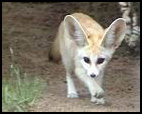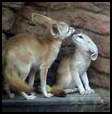

CURRENT RESEARCH
Comparative analyses of social evolution in mammals
My first research theme focuses on the evolution of social behavior and cooperative breeding in mammals. I am collaborating with Jan Zrzavý
and Jan Robovský. We use phylogenetic comparative methods to analyze evolution of sociality and associated life-history traits to explain origin and maintenance of the sociality.
- Is phylogeny a major determinant of the patterns of sociality?
- What is the mechanisms underlying evolution of social behavior?
- What is the role of body size changes in the evolution of sociality?
Canids
My favorite carnivores are unique among mammals in exhibiting a combination of prevailing monogamy with alloparental care, reproductive suppression, obligate pseudopregnancy and monestrum. What has driven development of the above reproductive anomalies?
There are several hypotheses competing for the explanation of group-living in canids. In general, first group of hypotheses emphasize the role of body size, imposing constraints on metabolic rate, reproduction and hunting strategies, underlying evolution of group-living. The second approach concludes that much of canid variation in social structure may be explained by focusing on resource availability.
Ethological research
We are conducting comparative ethological studies of various canid species in zoological gardens. The behavioral study of the less known species of the major clades would help us to understand factors that could favor evolution of sociality.
Fennec foxes (Vulpes zerda)
Cape foxes (Vulpes chama)
Bat-eared foxes (Otocyon megalotis)
Racoon dogs (Nyctereutes procyonoides)
Arvicolines
The voles (Arvicolinae) include approx. 150 species, with various degrees of subterranean adaptations and with remarkable species diversity in social organization and mating systems. Recent findings suggest that several vole species could be considered eusocial. The origin, evolutionary polarity and possible causes of sociality and cooperative breeding in the Arvicolinae are not clear.
We have finished the phylogeny of Arvicolinae and it reveals interesting results. The subterranean genera, sharing surprisingly high degree of the sociality are the most basal arvicolines, suggesting that the sociality could be an ancestral trait in this group.
Ethological research
We are currently conducting comparative studies of parental, affiliative and aggressive behavior, pair bonding and ability of kin recognition in Brandt voles (Microtus brandtii) and common voles (Microtus arvalis).
We are preparing data matrix for mongooses and we consider involving mole-rats in our research.
Research in Altai Mountains
My second research theme focuses on ecology and conservation of this peculiar region in southern Siberia. I am collaborating with Jan Riegert, Jan Robovský, Jan Matějů,
Karel Prach and Jan Zrzavý. Eva Semančíková and Martin Hais are responsible for GIS analyses. Erik Beever of the University of Alaska participates in pika research. We are planning population genetics research in collaboration with Štěpánka Hůlová and Oleg Brandler of the Moscow State University. We are working on the southern borders of Altai Republic (Russia).
Our study area includes Ukok Nature Park (UNESCO World Heritage Site) and Southern Chuyskiy Range. We closely cooperate with people of the Belyashi (Beleshi) village and local travel agency.
Altai links:
http://www.pacificenvironment.org/article.php?id=2563
http://pisum.bionet.nsc.ru/kosterin/landscap/altai/altai.htm
Fieldwork: Ecology of Altai mammals
We are conducting quantitative analyses of ecological requirements of the keystone species occupying Altai mountain grasslands.
-What is impact of livestock grazing, human activities and global climate changes on the target species?
Long-tailed ground squirrels (Spermophilus undulatus)
Gray marmots (Marmota baibacina)
Pikas (Ochotona alpina, O. pallasi, O. daurica)
We are preparing analyses of potential habitat of snow leopard (Uncia uncia) and argali sheep (Ovis ammon ammon) in Ukok Nature Park.
History of the Altai fauna and ecosystems
There are areas where reindeers, horses, saiga antelopes, wolverines, pikas and steppe lemmings live in sympatry. This is probably the only place in the world where we can encounter such a peculiar mixture of species.
- Is there a possibility of the continuous persistence of the Late Glacial faunal assemblages in Altai-Sayan region?
- What is role of the Altai-Sayan region in the postglacial history of mammalian fauna of Palearctic region?
Comparative analyses of social evolution in mammals: a phylogenetic approach (in cooperation with Jan Robovský, Radim Šumbera and Jan Zrzavý) (GAAV, 2008 – 2010)
We are participating on the project regarding the distribution and trends of alpine lagomorphs in North America and Altai Mountains (Erik Beever, April Craighead)
In preparation:
Ecological associations of Altai Animals - A Proxy to Understanding of European Glacial (in cooperation with Jan Riegert, Jan Robovský, Štěpánka Hůlová and Karel Prach)
Finished: